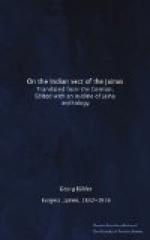Unfortunately the testimony to the ancient history of the Jainas, so far as made known by means of inscriptions, terminates here. Interesting as it would be to follow the traces of their communities in the later inscriptions, which become so numerous from the fifth century A.D. onwards and in the description of his travels by Hiuen Tsiang, who found them spread through the whole of India and even beyond its boundaries, it would be apart from our purpose. The documents quoted suffice, however, to confirm the assertion that during the first five centuries after Buddha’s death both the statements of Buddhist tradition and real historical sources give evidence to the existence of the Jainas as an important religious community independent of Buddhism, and that there are among the historical sources some which entirely clear away the suspicion that the tradition of the Jainas themselves is intentionally falsified.
The advantage gained for Indian history from the conclusion that Jainism and Buddhism are two contemporary sects—having arisen in the same district,—is no small one. First, this conclusion shows that the religious movement of the sixth and fifth centuries B.C. in eastern India must have been a profound one. If not only one, but certainly two, and perhaps more reformers, appeared at the same time, preaching teachers, who opposed the existing circumstances in the same manner, and each of whom gained no small number of followers for their doctrines, the desire to overthrow the Brahmanical order of things must have been generally and deeply felt. This conclusion shows then that the transformation of the religious life in India was not merely the work of a religious community. Many strove to attain this object although separated from one another. It is now recognisable, though preliminarily, in one point only, that the religious history of India from the fifth century B.C. to the eighth or ninth A.D. was not made up of the fight between Brahmanism and Buddhism alone. This conclusion allows us, lastly, to hope that the thorough investigation of the oldest writings of the Jainas and their relations with Buddhism on the one hand and with Brahmanism on the other will afford many important ways of access to a more exact knowledge concerning the religious ideas which prevailed in the sixth and fifth centuries B.C., and to the establishment of the boundaries of originality between the different systems.
APPENDIX A.
Copies of the mutilated inscriptions referred to, were published by General Sir A. Cunningham in his Archaeological Survey Reports, vol. III, plates xiii-xv. Unfortunately they have been presented from ‘copies’ and are therefore full of errors, which are due for the most part, doubtless, to the copyist and not to the sculptor. It is not difficult, however, in most cases under consideration here, to restore the correct reading. Usually only vowel signs are omitted or misread and, here, and there, consonants closely resembling one another as va and cha, va, and dha, ga and [’s]a, la and na are interchanged.




